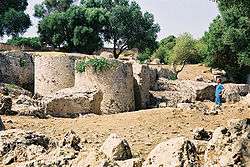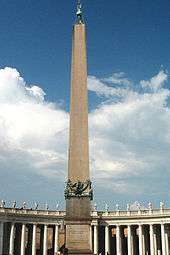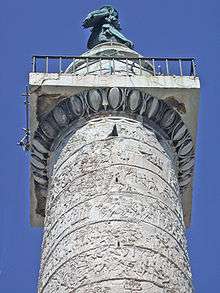List of ancient Greek and Roman monoliths
This is a list of ancient monoliths found in all types of Greek and Roman buildings.
It contains monoliths
- quarried, but not moved
- quarried and moved
- quarried, moved and lifted clear off the ground into their position (architraves etc.)
- quarried, moved and erected in an upright position (columns etc.)
Transporting was done by land or water (or a combination of both), in the later case often by special-built ships such as obelisk carriers.[1] For lifting operations, ancient cranes were employed since ca. 515 BC,[2] such as in the construction of Trajan's Column.[3]
It should be stressed that all numbers are estimations since only in the rarest cases have monoliths been actually weighed. Rather, weight is calculated by multiplying volume by density. The main source, J. J. Coulton, assumes 2.75 t/m³ for marble and 2.25 t/m³ for other stone.[4] For an explanation of the large margin of error, which often leads to widely differing numbers, see these introductory remarks.
Greek monoliths
Below a selection of Greek monoliths sorted by their date.
| Date |
Building / Object |
Location |
Monolith |
Weight
(in t) |
Comment |
| ~650 BC |
Dedication of Nikandre[5] |
Delos, Greek isles |
Figure |
000025 !~1110.25 |
|
| ~650 BC |
Fortification wall [5] |
Leontinoi, Sicily |
Wall blocks |
000175 !~1111.75 |
|
| ~640 BC |
Temple of Poseidon [5] |
Isthmus, Greek mainland |
Wall blocks |
000050 !~1110.5 |
|
| ~630 BC |
Temple A [5] |
Prinias, Crete |
Frieze slab |
000050 !~1110.5 |
|
| ~610–590 BC |
Sounion Kouros [5] |
Sounion, Greek mainland |
Figure |
000200 !111~2 |
|
| ~610–590 BC |
Colossus of the Naxians [5] |
Delos, Greek isles |
Base |
003400 !~1134 |
|
| ~610–590 BC |
Colossus of the Naxians [5] |
Delos, Greek isles |
Figure |
002300 !11~23 |
|
| ~590–580 BC |
Temple of Artemis [5] |
Kerkyra, Greek isles |
Pediment slab, central |
000325 !~1113.25 |
|
| ~590–580 BC |
Temple of Artemis [5] |
Kerkyra, Greek isles |
Architrave block |
000500 !~1115 or 6.25 |
|
| ~565 BC |
Temple of Apollo [5] |
Syracuse, Sicily |
Stylobate block |
002400 !~1124 |
|
| ~565 BC |
Temple of Apollo [5] |
Syracuse, Sicily |
Column shaft |
003500 !~1135 |
|
| ~565 BC |
Temple of Apollo [5] |
Syracuse, Sicily |
Architrave block |
002025 !~1120.25 |
|
| ~555 BC |
Olympieion [5] |
Syracuse, Sicily |
Stylobate block |
002025 !~1120.25 |
|
| ~560–550 BC |
Temple of Artemis [5] |
Ephesos, Asia Minor |
Architrave block, central |
004125 !~1141.25 |
|
| ~550–530 BC |
Temple C [5] |
Selinunte, Sicily |
Stylobate block |
001250 !~1112.5 |
|
| ~550–530 BC |
Temple C [5] |
Selinunte, Sicily |
Architrave block |
001600 !~1116 |
|
| ~540 BC |
Temple of Apollo [5] |
Corinth, Greek mainland |
Column shaft |
002600 !~1126 |
|
| ~540 BC |
Temple of Apollo [5] |
Corinth, Greek mainland |
Architrave block |
001000 !~1110 |
|
| ~535 BC |
Temple D [5] |
Selinunte, Sicily |
Architrave block |
001375 !~1113.75 |
|
| ~525 BC |
Temple FS [5] |
Selinunte, Sicily |
Architrave block |
002100 !~1121 |
|
| ~520 BC |
Kouros of Apollonas [5] |
Naxos, Greek isles |
Figure |
006900 !11~69 |
|
| ~520 BC |
Temple of Apollo [5] |
Naxos, Greek isles |
Lintel block |
002200 !~1122 |
|
| ~520 BC |
Temple of Apollo [5] |
Naxos, Greek isles |
Threshold |
002225 !~1122.25 |
|
| ~520 BC |
Temple at Parikia [5] |
Paros, Greek isles |
Lintel block |
002200 !11~22 |
|
| ~520–409 BC |
Temple of Apollo ('GT') [5] |
Selinunte, Sicily |
Column drum in quarry (Cave di Cusa) |
007300 !~1173 |
|
| ~520–409 BC |
Temple of Apollo ('GT') [5] |
Selinunte, Sicily |
Architrave block |
004000 !~1140 |
|
| ~520–409 BC |
Temple of Apollo ('GT') [5] |
Selinunte, Sicily |
Cornice block |
001250 !~1112.5 |
|
| ~515 BC |
From about that time on, cranes are assumed to have become common on Greek construction sites, leading to a sharp reduction of block sizes.[2] |
| ~515 BC |
Olympieion [5] |
Athens, Greek mainland |
Column drum |
000900 !~1119 |
|
| ~500–406 BC |
Olympieion [5] |
Akragas, Sicily |
Abacus block, central |
001150 !~1111.5 |
|
| ~500–406 BC |
Olympieion [5] |
Akragas, Sicily |
Architrave block |
000925 !~1119.25 |
|
| ~500–406 BC |
Olympieion [5] |
Akragas, Sicily |
Architrave block |
001100 !~1111 |
|
| ~500–406 BC |
Olympieion [5] |
Akragas, Sicily |
Architrave block |
001400 !~1114 |
|
| ~500–406 BC |
Olympieion [5] |
Akragas, Sicily |
Metope block, lower (angle) |
001350 !~1113.5 |
|
| ~500–406 BC |
Olympieion [5] |
Akragas, Sicily |
Cornice block |
001150 !~1111.5 |
|
| ~500 BC |
Temple of Aphaia [5] |
Aigina, Greek isles |
Column shaft |
000600 !~1116 |
|
| ~480–460 BC |
Temple ER [5] |
Selinunte, Sicily |
Architrave block |
001700 !~1117 |
|
| ~468–457 BC |
Temple of Zeus [5] |
Olympia, Greek mainland |
Stylobate block |
000850 !~1118.5 |
|
| ~468–457 BC |
Temple of Zeus [5] |
Olympia, Greek mainland |
Architrave block |
001650 !~1116.5 |
|
| ~460 BC |
Temple of 'Poseidon' [5] |
Paestum, Magna Graecia |
Architrave block |
001150 !~1111.5 |
|
| ~448–437 BC |
Parthenon [5] |
Athens, Greek mainland |
Architrave block |
000950 !~1119.5 |
|
| ~448–437 BC |
Parthenon [5] |
Athens, Greek mainland |
Lintel block, largest |
000900 !~1119 |
|
| ~437–432 BC |
Propylaia [5] |
Athens, Greek mainland |
Architrave block, central |
001250 !~1112.5 |
|
| ~437–432 BC |
Propylaia [5] |
Athens, Greek mainland |
Lintel block, largest |
001225 !~1112.25 |
|
| ~437–432 BC |
Propylaia [5] |
Athens, Greek mainland |
Lintel block, relieving [A 1] |
000875 !~1118.75 |
|
| ~437–432 BC |
Propylaia [5] |
Athens, Greek mainland |
Ceiling beam, west porch |
001000 !~1110 |
|
| ~421–405 BC |
Erechtheion [5] |
Athens, Greek mainland |
Block over Pandroseion |
001150 !~1111.5 |
|
| ~421–405 BC |
Erechtheion [5] |
Athens, Greek mainland |
Lintel block, north door |
000725 !~1117.25 |
|
| ~421–405 BC |
Erechtheion [5] |
Athens, Greek mainland |
Ceiling beam, north porch |
001000 !~1110 |
|
| ~420 BC |
Temple of Segesta [5] |
Segesta, Sicily |
Architrave block |
001250 !~1112.5 |
|
| ~366–326 BC |
Temple of Apollo [5] |
Delphi, Greek mainland |
Architrave block |
000925 !~1119.25 |
|
| ~340 BC |
Temple of Zeus [5] |
Nemea, Greek mainland |
Architrave block |
000675 !~1116.75 |
|
| ~340 BC |
Temple of Zeus [5] |
Nemea, Greek mainland |
Lintel block |
000875 !~1118.75 |
|
| ~350 BC |
First in Ionia, the weight of the lifted blocks begins to match again that of the Archaic period, indicating a mastery of the winch and compound pulley hoist by now.[6] |
| ~310 BC |
Temple of Apollo [5] |
Didyma, Asia Minor |
Threshold |
004675 !~1146.75 |
|
| ~310 BC |
Temple of Apollo [5] |
Didyma, Asia Minor |
Lintel block [A 2] |
004800 !~1148 |
|
| ~310 BC |
Temple of Apollo [5] |
Didyma, Asia Minor |
Jamb [A 3] |
007150 !~1171.5 |
|
| ~170 BC |
Olympieion [5] |
Athens, Greek mainland |
Architrave block, largest |
002325 !~1123.25 |
|
|
Roman monoliths
Below a selection of Roman monoliths sorted by their date; the list also includes work on Greek temples which was continued into the Roman era.
| Date [A 4] |
Building / Object |
Location |
Monolith |
Weight
(in t) |
Comment |
| 000 !1st c. BC |
Apollo statue [5] |
Vitr. 10.2.13 [7] |
Base |
005100 !~1151? |
|
| 002 !10 BC |
Flaminian Obelisk [8] |
Rome, Italia |
Obelisk |
026300 !~1263 |
From Roman Egypt by obelisk ship[8] |
| 002 !10 BC |
Campensis Obelisk [8] |
Rome, Italia |
Obelisk |
023000 !~1230 |
From Roman Egypt by obelisk ship[8] |
| 037 !37–41 AD |
Vatican Obelisk [9] |
Rome, Italia |
Obelisk |
036100 !~1361 |
From Roman Egypt by obelisk ship[8] |
| 100 !1st–2nd c. |
Stone of the South [10] |
Baalbek, Roman Syria |
Block in quarry |
100000.12 !~1000.12 |
|
| 100 !? |
Unnamed monolith [11] |
Baalbek, Roman Syria |
Block in quarry |
124200 !~1242 |
|
| 100 !1st–2nd c. |
Layer beneath Trilithon [12] |
Baalbek, Roman Syria |
Blocks, several |
035000 !~∅350 |
Podium of Jupiter temple |
| 100 !1st–2nd c. |
Trilithon [12] |
Baalbek, Roman Syria |
Blocks, three |
080000 !~∅800 |
Podium of Jupiter temple |
| 100 !1st–2nd c. |
Temple of Jupiter [5] |
Baalbek, Roman Syria |
Column drum, lower |
004850 !~1148.5 |
|
| 100 !1st–2nd c. |
Temple of Jupiter [5] |
Baalbek, Roman Syria |
Architrave-frieze block, central |
006300 !~1163 |
Lifted by cranes to height of 19 m[13] |
| 100 !1st–2nd c. |
Temple of Jupiter [5] |
Baalbek, Roman Syria |
Cornice block, corner |
010800 !~1108 |
Lifted by cranes to height of 19 m[13] |
| 101 !1st–3rd c. |
Granite column [14] |
Mons Claudianus, Roman Egypt |
Column shaft in quarry |
020700 !~1207 |
|
| 113 !113 |
Trajan's Column [15] |
Rome, Italia |
Pedestal |
007700 !11~77 |
|
| 113 !113 |
Trajan's Column [16] |
Rome, Italia |
Base |
005500 !~1155 |
|
| 113 !113 |
Trajan's Column [17] |
Rome, Italia |
Column drum, typical |
003200 !11~32 |
|
| 113 !113 |
Trajan's Column [16] |
Rome, Italia |
Capital |
005330 !~1153.3 |
Lifted by cranes to height of 34 m[16] |
| 150 !2nd c.? |
Temple of Apollo [5] |
Didyma, Asia Minor |
Architrave block |
002050 !~1120.5 |
|
| 297 !297 |
Pompey's Pillar [18] |
Alexandria, Roman Egypt |
Column shaft |
028500 !~1285 |
|
| 306 !306–313 |
Basilica Nova [5] |
Rome, Italia |
Column shaft |
010300 !~1103 |
|
| 357 !357 |
Lateran Obelisk [19] |
Rome, Italia |
Obelisk |
045500 !~1455 |
From Roman Egypt by obelisk ship[8] |
| 530 !530 |
Mausoleum of Theodoric [20] |
Ravenna, Italia |
Roof slab |
023000 !~1230 |
Constructed under Ostrogoths[A 5] |
|
Gallery
Greek monoliths
-
Nikandre Dedication (0.25 t)
-
-
The existence of the U-shaped channels on the stone blocks (here at the Temple of Heracles) points at the use of cranes for lifting them into place.[1]
-
Colossos of Apollona (~69 t)
-
-
- ^ Coulton 1974, p. 7
Roman monoliths
Notes
- ↑ If in two blocks.
- ↑ If monolithic.
- ↑ If monolithic.
- ↑ In case of Egyptian obelisks, date of ship transport to Rome.
- ↑ Although the mausoleum reflects Ostrogothic style, the method for moving the monolithic roof slab and positioning it on top of the building relied on the continuity of Roman techniques into the reign of Theoderic.
See also
References
- ↑ Wirsching 2000
- 1 2 Coulton 1974, pp. 7, 16
- ↑ Lancaster 1999, pp. 419–439
- ↑ Coulton 1974, p. 14
- 1 2 3 4 5 6 7 8 9 10 11 12 13 14 15 16 17 18 19 20 21 22 23 24 25 26 27 28 29 30 31 32 33 34 35 36 37 38 39 40 41 42 43 44 45 46 47 48 49 50 51 52 53 54 55 56 57 58 59 60 61 62 Coulton 1974, pp. 17–19 (appendix); remaining data taken from text
- ↑ Coulton 1974, p. 16
- ↑ Vitruvius: De Architectura, Book 10
- 1 2 3 4 5 6 Wirsching 2000, p. 271 (table 1)
- ↑ Lancaster 1999, p. 428
- ↑ Ruprechtsberger 1999, p. 15
- ↑ Ruprechtsberger 1999, p. 17
- 1 2 Adam 1977, p. 52
- 1 2 Coulton 1974, pp. 16, 19
- ↑ Maxfield 2001, p. 158
- ↑ Lancaster 1999, p. 430
- 1 2 3 Lancaster 1999, p. 426
- ↑ Jones 1993, p. 32
- ↑ Adam 1977, pp. 50f.
- ↑ http://www.pbs.org/wgbh/nova/egypt/raising/rome.html
- ↑ Heidenreich & Johannes 1971, p. 63
Sources
- Adam, Jean-Pierre (1977), "À propos du trilithon de Baalbek: Le transport et la mise en oeuvre des mégalithes", Syria, 54 (1/2): 31–63, doi:10.3406/syria.1977.6623
- Coulton, J. J. (1974), "Lifting in Early Greek Architecture", The Journal of Hellenic Studies, 94: 1–19, doi:10.2307/630416
- Heidenreich, Robert; Johannes, Heinz (1971), Das Grabmal Theoderichs zu Ravenna, Wiesbaden: Franz Steiner Verlag
- Jones, Mark Wilson (1993), "One Hundred Feet and a Spiral Stair: The Problem of Designing Trajan's Column", Journal of Roman Archaeology, 6: 23–38
- Lancaster, Lynne (1999), "Building Trajan's Column", American Journal of Archaeology, 103 (3): 419–439, doi:10.2307/506969
- Maxfield, Valerie A. (2001), "Stone Quarrying in the Eastern Desert with Particular Reference to Mons Claudianus and Mons Porphyrites", in Mattingly, David J.; Salmon, John, Economies Beyond Agriculture in the Classical World, Leicester-Nottingham Studies in Ancient Society, 9, London: Routledge, pp. 143–170, ISBN 0-415-21253-7
- Ruprechtsberger, Erwin M. (1999), "Vom Steinbruch zum Jupitertempel von Heliopolis/Baalbek (Libanon)", Linzer Archäologische Forschungen, 30: 7–56
Further reading
- Lewis, M. J. T. (1984–5), "Roman Methods of Transporting and Erecting Obelisks", Transactions of the Newcomen Society, 56: 87–110, doi:10.1179/tns.1984.005
- Wirsching, Armin (2000), "How the Obelisks Reached Rome: Evidence of Roman Double-Ships", The International Journal of Nautical Archaeology, 29 (2): 273–283, doi:10.1111/j.1095-9270.2000.tb01456.x
- Wirsching, Armin (2003), "Supplementary Remarks on the Roman Obelisk-Ships", The International Journal of Nautical Archaeology, 32 (1): 121–123, doi:10.1111/j.1095-9270.2003.tb01438.x
External links
- Traianus – Technical investigation of Roman public works
_-_n._0275_-_Selinunte_-_Rovine.jpg)













